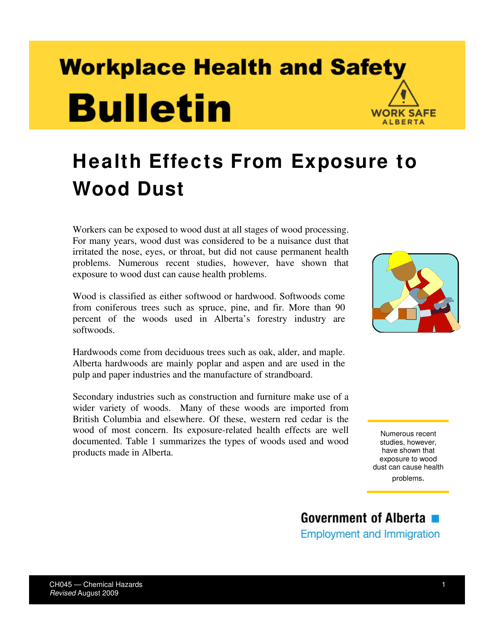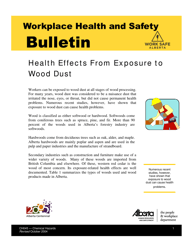Form CH045 Health Effects From Exposure to Wood Dust - Alberta, Canada
Form CH045 Health Effects From Exposure to Wood Dust in Alberta, Canada is a document that serves as a tool for assessing and documenting the health effects resulting from occupational exposure to wood dust. This form is specific to the province of Alberta in Canada and is likely used by employers and health professionals to track and address any health issues related to wood dust exposure in the workplace. It helps in complying with occupational health and safety regulations, ensuring the well-being of workers, and preventing any adverse health effects associated with wood dust inhalation.
The Form CH045 for reporting health effects from exposure to wood dust in Alberta, Canada is typically filed by the individual who has experienced the health effects. This form serves as a method for individuals to report any adverse health issues they have encountered due to exposure to wood dust, allowing authorities to track and address potential health hazards.
FAQ
Q: What are the health effects of exposure to wood dust?
A: Exposure to wood dust can cause various health effects, including respiratory issues and allergic reactions. Prolonged exposure may lead to conditions such as asthma, bronchitis, and nasal cancer.
Q: How does wood dust affect the respiratory system?
A: Inhalation of wood dust can irritate the respiratory system, leading to symptoms such as coughing, wheezing, and shortness of breath. Prolonged exposure may result in chronic respiratory conditions and reduced lung function.
Q: Are some individuals more susceptible to wood dust-related health effects?
A: Yes, certain individuals may be more vulnerable to the health effects of wood dust. People with pre-existing respiratory conditions, such as asthma or allergies, are at a higher risk. Additionally, prolonged exposure increases the likelihood of developing related health issues.
Q: What precautions should be taken to minimize exposure to wood dust?
A: To minimize exposure to wood dust, it is important to use appropriate ventilation systems and dust control measures. Workers should wear personal protective equipment, such as respirators and goggles. Regular cleaning of work areas and maintaining good hygiene practices can also help reduce exposure.
Q: Is wood dust considered a carcinogen?
A: Yes, wood dust, particularly from certain tree species like oak, beech, and walnut, has been classified as a Group 1 carcinogen by the International Agency for Research on Cancer (IARC). Prolonged exposure to these wood dusts increases the risk of developing nasal cancer.
Q: Are there any regulations or guidelines for wood dust exposure in Alberta, Canada?
A: Yes, Alberta has regulations and guidelines in place regarding occupational exposure to wood dust. Employers are required to assess and control exposure risks, provide training to workers, and ensure compliance with applicable standards.
Q: What industries or occupations are at a higher risk of wood dust exposure?
A: Industries such as woodworking, furniture manufacturing, and construction are commonly associated with wood dust exposure. Occupations like carpentry, cabinetmaking, and sawmill operations also entail a higher risk of exposure to wood dust.
Q: Can wood dust exposure be prevented?
A: While complete elimination of wood dust exposure may not be possible in certain industries, various preventive measures can be implemented. Adequate dust extraction systems, proper ventilation, and the use of personal protective equipment can greatly reduce the risk of exposure.
Q: What are the symptoms of wood dust allergies?
A: Wood dust allergies can manifest in symptoms such as sneezing, nasal congestion, runny nose, itching, and skin rashes. If an individual experiences these symptoms in relation to wood dust exposure, they should seek medical advice.
Q: Is there a safe level of wood dust exposure?
A: No level of wood dust exposure is completely safe, as it carries potential health risks. However, regulatory authorities establish permissible exposure limits (PELs) to guide occupational safety standards and minimize exposure risks. It is important to adhere to these guidelines.



















